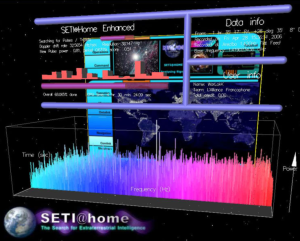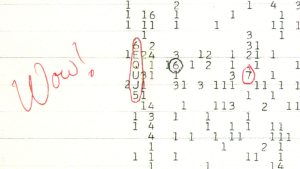Is SETI@Home Dead?
If you’re like us you may be wondering, “Is SETI@Home Dead?”. If you closely followed SETI (Search for Extraterrestrial Intelligence) and their volunteer program allowing everyday people to aid in the search for alien radio signals remotely, then you knew that, in March 2020, front end-user participation came to an abrupt stop after 20 years, and you wouldn’t be able to play along anymore. Others come back after their own hiatus (after giving their computers a break from intense background use, or winding up with a new spare) only to find the SETI@Home program isn’t currently available, sadly searching why.
Is it gone for good?

Background
In 1999 SETI made free software available for download to at-home users all over the world, through University of California, Berkeley. This allowed SETI to break free of the constraints of limited computing power, crowd-sourcing more than they could afford or support in-house. Everyday folks could use their spare computing power to help analyze radio telescope data acquired from the likes of the Aricebo Observatory and distributed to them in bite-size blocks for their own computers to chew on at home, looking for potential signs of alien radio transmissions. After the data was sifted through, results were uploaded back to SETI@Home headquarters.
As the Atlantic put it, astronomers “deputized” internet users to help find extraterrestrial signals. I can personally attest to it having been an extremely exciting, free activity in which to initially participate, and to which I’d occasionally return for two decades. Reasons for down time included mitigating extra strain on a computer I was trying to get maximum use out of, and reasons for returning included realizing I had a spare knockabout box to dedicate to the cause. At one point I got space game squad-mates from Jumpgate to participate as a team.
What Happened?
I, the author, for example, had been away from SETI@Home for several years, preoccupied as I often was in-between volunteering CPU/GPU hours. I returned with revitalized zeal to see it running again (and had a spare, expendable PC turn up to dedicate once again) only to discover new blocks of data are no longer being distributed – and haven’t been for some time. Compounding the let-down confusion were numerous, prevalent SETI@Home and Berkeley center-stage pages like “Participate” and “Join” still not being updated to reflect the change to this day, 2 years after the close. I’d re-installed the client BOINC (the client portion of the platform that fueled the program for most of its days) only to find SETI@Home not available as a program to activate with the software. Adding to the confusion was that, even 2 years later, certain, prominent webpages of the project like Participate aren’t updated and still instruct you to go ahead. It’s easy to follow them straight from Google and miss a small notice it’s in vain.
Anyway:
The number crunching we users did for SETI@Home was a Phase I tier of the analysis, preparing it for subsequent analyses. They’ve stated that they have enough data having completed that stage for now, and subsequent stages of analysis don’t appear to be considered for crowd-souring in the same manner. Anecdotal reasons stated by general, 3rd-party media keep citing reasons like the limited bandwidth of private internet connections, but that doesn’t satisfy questions about why it was practical to dole phase 1 out to us beginning back in 28 kbps dialup days as bulk, “crude oil” data, yet 80,000 kbps is now too slow to dole the subsequent barrels of clean oil for refinement into gasoline. It all makes perfect sense on their end but the average article pokes around with anecdotes that don’t add up by themselves. Journalists repeat how internet speed is limited compared to drawing it off the archives directly in-house. Journalists repeat how the raw data was shipped physically on tapes and then disk drives from Arecibo to the US instead of trying to do it online. In the end, it appears latter-phase crunching is something they feel is more efficient to run in-house, sitting on 20 years of Phase 1 data directly, instead of doling it out all over again.
One thing they do talk about is an extremely complex and probably ever-changing set of criteria being used as filter parameters. From insane noise and interference removal processes, to potentially rectifying frequency-skewing doppler shift effects of bodies in motion, and much, much more, the latter stages of the data refinement are incomprehensibly extensive and convoluted. It’s probably too much to try to narrow down to client updates as it is constantly modified, as the science is tweaked regularly.
Is SETI@Home Dead or What?
Is it gone for good or in hibernation?
As of right now there is no update on whether of not front end-users of SETI@Home will be treated with data blocks to crunch once again or not. One of the biggest variables is how interesting the subsequent “Nebula” analyses of 20 years of the phase 1 data truly is. Nebula is the name of the back-end software being used to further crunch the front-end SETI@Home crowd-sourced results (as well as some other data such as from another front-end source called SERENDIP or “Search for Extraterrestrial Radio Emissions from Nearby Developed Intelligent Populations”). Nebula appears to be available for download on places like SourceForge, but it’s not some user-friendly thing for the general public like SETI@Home. It requires substantial hardware just to house the database and would be most approachable to set up and run with ample computer science experience. It’s currently being run on the Atlas supercomputer cluster at Einstein@home.
When I asked if SETI@Home was expected to fire back up for remote use some day, veteran participant “Wiggo”, who racked up an estimated 289,427 hours of CPU time running SETI@Home out of Australia between Jan. 2000 and March 2020 replied, “Some of us are waiting in the hope that Nebula will result in findings that will kick things off again with better tuned processes.”
The crowd-sourcing platform BOINC that powered SETI@Home is not only, still available for download, but is going strong allowing at-home volunteers lend computing power to different projects, seeking advancement in fields like biochemistry and medicine.

